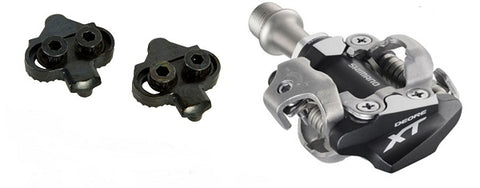Time Atac pedals are an SPD-style mountain bike pedal, designed for offroad riding. The SPD-design is based on a small, steel or metal cleat that is mounted in a small recess in the tread of a shoe to allow the rubber tread to touch the ground. That's instead of walking on the cleats - like a road bike setup with the clip-clop of road bikers at a cafe. The result is a walkable shoe design with the ability to clip firmly into your pedals. There are many companies that make SPD-style pedals, and Shimano and Time are two of the biggest. I first converted from flat pedals to clipping in on my mountain bike in 1997, with a pair of Shimano SPD pedals. I learned to love being clipped in for the ability to jump with the bike, pedaling through rough terrain, and just better overall control of the bike.

Shimano SPD-style XT pedal

Time Atac carbon pedals
After a couple years riding clipped in, I switched to Time Atac pedals on the advice of a friend and have never looked back. Here's why:
MUD CLEARANCE

Above, you have a Time cleat mounted on a shoe, and well worn. After putting your foot down in mud or dirt, some of it inevitably gets caught in the cleat interface. On a Time cleat, you cram it on the pedal, clip in, wiggle it back & forth a bit, and the mud clears out either side of the cleat. You're good to go.

On a Shimano cleat, there are four internal corners that collect mud, small pebbles, and sand. It gets wedged in there and won't come out. At times it's almost impossible to click into the pedal, or you aren't firmly in the pedal and pop out unexpectedly when lifting on the pedal - like doing a jump or tight corner under loads. Many times I've sat beside the trail with a twig or allen key, digging out a Shimano cleat so I can click back into the pedal.

DURABILITY
The Time Atac has two springs, two square steel bars, and a pedal body. That's about it. Simple, durable, and solid. Shimano and other similar SPD-style pedals have lots of screws, plates, four or more springs... A lot to get rusted, gummed up with mud, and harder to operate as they get older. I recently retired a pair of Atac MTB pedals that lasted me over 15 years of hard use, so they get my vote for durability, but the design of the pedal and cleat interface is what I like most.
The cleats being made of brass does allow them to wear out faster, since brass is a soft metal. I find that I have to replace my cleats every year or so, but they are inexpensive and readily available at Time pedal dealers.
OTHER UNIQUE ATTRIBUTES
Cleats - Time cleats are brass, which wears a little faster than steel, but allows the pedals to be made of a lighter material with less steel on the body.
Variable release angle - The cleats also have a variable release angle that can be changed by switching the cleats from right to left on the shoes. This allows the rider to choose faster, sharper release angle, or a wider angle that allows the rider to move around on the bike more without accidentally unclicking when moving around on the pedal.
Lightweight - the composite France edition weighs 294g at $159AU versus the Shimano XT at 340g and $189AU. The entire range of Time pedals are simple, and much lighter than their main competitors.
MARKET TRENDS
In Australia, Shimano has a very large presence, with their components distributed by a subsidiary of Shimano Japan. The pedals are convenient for retailers to stock, and they have a large selection. Time pedals, on the other hand, are a much smaller company and although they have a better product in my opinion, they rely on smaller independent distributors here in Australia to gain market share. If you go to bigger markets like the USA and Europe, Time commands a much larger portion of the market, but has struggled to get the wide distribution here in Australia; less people see it, less people know it, might as well go with the easy and familiar choice. We carry the Time pedals at our store because I believe in them and they've proven to be a better product in almost every situation.
Time's Atac models vary in price from $159AU to well over $300AU, but regardless of the price, they all function the same. Weight varies with the lighter ones being more expensive due to upgrades in pedal body (composite plastic or carbon), and the spindle (steel, cromoly, titanium) and a few other small feature upgrades.
Overall, I highly recommend Time Atac pedals for their durability, ease of use, weight, and natural mud clearance. They've served me well over the years with no issues to speak of. When buying your first pair of MTB pedals or making your next upgrade, give them a consideration.






100%! I’ve been riding time pedals since 2004 on MTB and recycled the same ones to my gravel bike now. Love them.
Thanks for the review. It has helped me confirm the Time Atac as the pedal I will put on the new gravel bike I am putting together.
Durable? Lots of people suggest replacing pedals after 5 or 6 years,. My first pair of ATAC pedals have lasted 20 years longer than that! I do need to replace the cleats after about 5 years. I initially bought 5 pairs of cleats, because I figured Time would stop selling them before the pedals died. My pedals have been on all purpose bikes that take me to mud and màlls. The cleats are completely recessed on many shoes (mall) and don’t get clogged (mud). You don’t mention that they function well when iced up, but maybe that is less of a consideration in Australia compared to Canada.
I’m also a Time convert. The main reason in my case was knee problem. The lateral float saved me. I also prefer the way they click in and out. They also feel more stable. The durability: I think shimanos are better. Time body wears, engagement system develops play. Bearings are much worse and cleats wear out very fast and that’s a big cost. I need new cleats every 9 months. Shimano cleats are much more durable. You said you enjoyed Time pedals for 15 years. Means 15 pairs od cleats in your case. It’s cost of roughly 3 pairs of XT pedals :) Of course Shimano cleats wear too but the rate is 2x or 3x slower from my expirience. Still I love Time. Cheers!